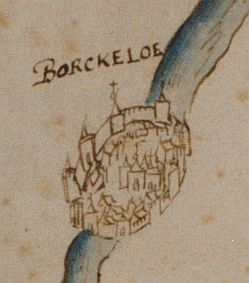 "Court at Borculo" "Court at Borculo"
During the years of researchng about the town of Borculo, the "Hof" or "Court" the town formed around, I began to see a few etchings, paintings and sketches of "Het Hof Borculo". Not all looked exactly the same. At first I thought it all might have been nothing more than artistic license or interpretation. However, some were drastically different and I began to question which one, if any, were accuarate.
Before we dive into that I think it is worthwhile to look at what role it played in the family history of the Van Burklow (and similar) families that exist now. By all research I can gather we aren't descendants of the Lord of the manor or any of his family members. If any relationship exist it is as one of the "Lord of The Manor" being our earliest ancestor's "fuedal Lord". He would have most likely provided some sort of protection and collected taxes from those who lived in the area of his Lordship
As you can see in the draing below Borculo was a "fortified City". The city walls were equipped with a palisade and two gates. Also visible are the church, with the turn having an unfinished roof, and the mill complex both of which still exist today. This would help to give a perspective or orientation to the old drawing and modern city.
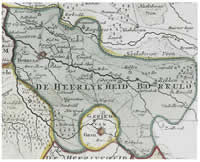 I have not found a lot of writings about how the Lord of the manor treated the locals. There is one account of a Lubberdink family member spending a few days in the cellar of the hof as a result of a few violations of the Lord's rules. Once was for poaching some deer and the other time for cutting and taking wood from the Lord's property. I have not found a lot of writings about how the Lord of the manor treated the locals. There is one account of a Lubberdink family member spending a few days in the cellar of the hof as a result of a few violations of the Lord's rules. Once was for poaching some deer and the other time for cutting and taking wood from the Lord's property.
It is clear that Borculo did play a political role in the region and therefore I suspect the various Lords of Borculo would have kept a fairly firm grip on what went on in their Lordship. They Lords of Borculo weren't just country gentleman with a large hof, land and money. This is one of the reasons I suspect our ancester came to New Amsterdam with the name "Van Borculo" instead of Lubberidink. It would have been more well known and relative to those they met. The importance of Borculo is evident when looking at the efforts to resolve the, "Borculo Question". after the passinf of the Borculo family from the hof, Borculo was then ruled by the counts of Limburg and Bronkhorst. In the long conflict (known as the, "Borculo Question".
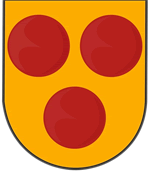 It is evident going back as far as May 06, 1288 when Hendrik III van Borculo sat on his horse with his family crest on his shield on the battlefield as a knight ready for the Battle of Worringen, Cologne, North Rhine-Westphalia, Germany. Hendrik III was there in support of Reinald of Guelders in an effort to protect the rights of their lands against an effort of expansion by German Kings and land holders. This had been an ongoing struggle with many small actions that changed things very little. On the day there were approimately 1100 fatalities, most of the male relatives of the later German emperor Henry VII perished there. Hendrik III van Borculo also lost his life in defense of his lands and Borculo It is evident going back as far as May 06, 1288 when Hendrik III van Borculo sat on his horse with his family crest on his shield on the battlefield as a knight ready for the Battle of Worringen, Cologne, North Rhine-Westphalia, Germany. Hendrik III was there in support of Reinald of Guelders in an effort to protect the rights of their lands against an effort of expansion by German Kings and land holders. This had been an ongoing struggle with many small actions that changed things very little. On the day there were approimately 1100 fatalities, most of the male relatives of the later German emperor Henry VII perished there. Hendrik III van Borculo also lost his life in defense of his lands and Borculo
The "Borculo Question" arose between the heirs of the last count of Limburg-Bronkhorst and the Prince-Bishop of Munster over ownership of Borculo. The Court of Gelderland ruled on 20 December 1615 in favour of count Joost van Limburg and Bronkhorst. The ruling was imposed by troops from Zutphen, taking over the castle and city of Borculo in February 1616 after short combat. Prince Bishop Christoph Bernhard von Galen, tried again twice to keep Borculo under Munster's authority, but without success. Thereafter, Borculo definitely belonged to the province of Guelders instead of Munster.
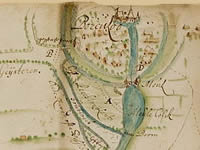 With the political and religious struggles in the area, why would anyone build a castle in Borculo and then risk so much to defend it. There were some very good reasons in support of a castle. In 1645 the area around the castle was descibed as being very marshy and difficult to cultivate. The marshy lands would have made the castle very defensible. Additionally there were many streams in the area which would have provided an ample supply of water for the moats. Additionally the water in the area, specifically the Berkel River, provided some potential for commerece through water traffic, shipping and eventually a water mill. (Which still exists to this day) About this time canals were being added to the area which increased potential for revenue. More revenue equated into power and influence. With the political and religious struggles in the area, why would anyone build a castle in Borculo and then risk so much to defend it. There were some very good reasons in support of a castle. In 1645 the area around the castle was descibed as being very marshy and difficult to cultivate. The marshy lands would have made the castle very defensible. Additionally there were many streams in the area which would have provided an ample supply of water for the moats. Additionally the water in the area, specifically the Berkel River, provided some potential for commerece through water traffic, shipping and eventually a water mill. (Which still exists to this day) About this time canals were being added to the area which increased potential for revenue. More revenue equated into power and influence.
Other reasons in defense of building a castle in Borculo would include its position in relationship to Zutphen and Vreden. Also the area of the Province of Gelderland known as the "Achterhoek" was in a very central location to other castles in the region. The importance of the area can also be reinforced by the earliest efforts to build the castle going back to about 1150.
Going forward the houses of Van Borculo and Van Bronckhorst established good relationships with neighboring landlords. This was reinforced in the 15th century with the Knighthood and taxation by the lord of Borculo.
By 1743 the Het Hof Borculo had taken on a prominent look befitting of a Lord. The moats were
well established. Nearby there was a water wheel with acess to canals. As discussed earlier, and evident in this picture, the hof was very defensible being surrounded by water on all sides. It was located on what is now often referred to as, "The Island". The surrounding water and canals also served the purposed of drainage which in essence created the polder, or island.
Another reason for the various looks of the hof, or court, was that it saw work and rennovation from time to time. Construction and renovation had been underway since 1639 with "120 balck parts" shipped in from Amsterdam with carpenters and a glazier from Zutphen. At a cost of 36 Guilders 2 "birdwatches" were made by Hendrick Lievers.
("In current spelling a 'balk' is a wooden beam and I presume this 'balck' would be the old dutch for it. The parts may also be ' party' which in current would spell 'partij' meaning a collection of items
In this case wooden beams." Source: Han Geerligs)
Het Hof Borculo had a real court life. There were payments made to a French cook, Andries de Buyre, the gardener Bartelt Straetman and several stableman, kitchen assistants and girls.
Improvements continue into 1642 when more than 57,000 stones were transported for major rennovaitons. Additional money was spent on screeds (floor tiles), fire bricks. There was also new construction of a stable, bakehouse and a brewery house for the hof. Other improvements included a new gate and bridges. This expansion would have been taking place in plain view of our early Lubberdink-Van Borculo ancestors.
However, it appears a financial hole was also being dug. About this time, "her gracious graces" (The two daughters of the Lord of Borculo) traveled to Paris where they spent no less than 4,000 guilders. This was all borrowed money and the family was already living beyod their means. Back at the hof 1,214 guilders was handed over to the "gold leather maker to Amseterdam Marten van Hovel for golden leather the great zael and turreets in Borkelo". In March another 50,000 "root stones" and 10,000 small stones arrived from Deventer. Consumption of goods and materials continued throughtout 1642 with 120 trees being felled in Neede for the construction of a "sledge" (sled) for the lord.
By the mid 1700s "Hof te Borculo" (Court of Borculo) had changed once again as seen in the picture above. By 1727 the house was no longer inhabited by the lord of Borculo. The debt of renovations and operation had finally taken their toll. In 1727 the hof was sold by Count Leopold of Limburg and the Bronckorst family to Count Carl Philips of Flodroff-Warensleben. The castle was no longer inhabited and the structure was in decline. The large castle lasted until about 1760 when, apart from the large cellars, was taken down and replaced with a new design.
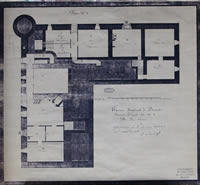 The new design would be an "L" shaped floorplan more in the style of a country house. This floorplan is first depicted on the map of Ravenschot in 1763. The original cellars were all that remained of the once prominemt and important castle Borculo. The new design would be an "L" shaped floorplan more in the style of a country house. This floorplan is first depicted on the map of Ravenschot in 1763. The original cellars were all that remained of the once prominemt and important castle Borculo.
As time passed the new house became a stud farm. By 1813 plans were put in place fir an extensive rennovation of the imperial stud farm which had been established in 1806 when an accurate map of the cellars was also made for the first time.
Up until this time the Netherlands (Holland) had been annexed by France. When Napolean suffered heavy losses at Leipzig in October-November of 1813 it meant an end to his empire. It also ended his plans for "Haras impériaux" (Imperial Stud Farms) used to offset the high consumption of military horses. Napolean fled to France with the stallions and renovations plans. The Borculo complex was not used again as a State Stud Farm until 1820.
This is a sketch of the Imperial Stud Farm plans from 1802-1810 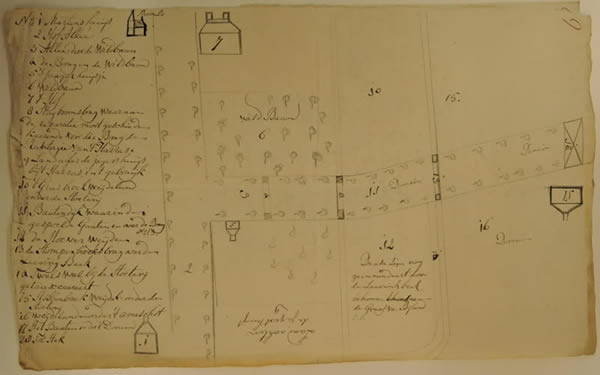 At this time the Court of Borculo was part of the royal estate of King Louis Naplolean of Holland.
Above is the blue print of the "L" shaped estate that replaced the original Castle of Borculo
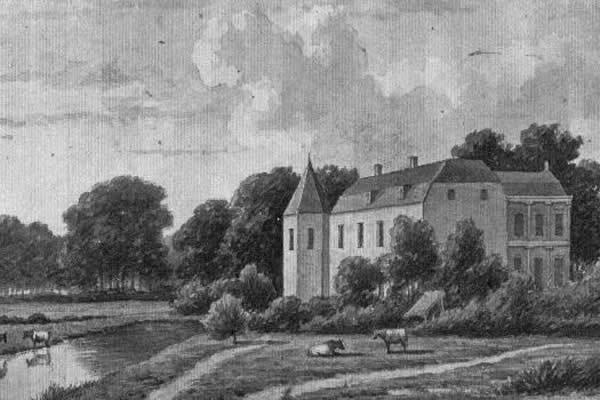
The "Court of Borculo" stud farm c. 1813
In 1817 a map was done of Borculo detail the location and design of the Hof and the surrounding area.
There is very little that remains of the original "hof" and "court" of Borculo. One of the "Keeps" is part of the local museum near the city center. All other remians, such as the foundation and cellars are below street level. An opportunity arose in 1993 to dig up the foundation of the keep - the large defense tower. The excavation confirmed the information in the archives. Specifically it confirmed the castle had been demoslished to ground level.
A few images of the cellars were taken in 1968. Below are thumbnails of those images. Click on the images to see larger versions of those images.
In the modern day the current company Meilink.eu use to be situated next to the current Hof and have a small harbour where wood was brought in over the river Berkel to be cut to beams and planks. (Image proided by Hans Geerligs)
Information Source - VIEW
Borculo Historical Association - Visit (in Dutch)
Borculo City History - READ
Hans Geerligs - (Borculo Resident)
|

